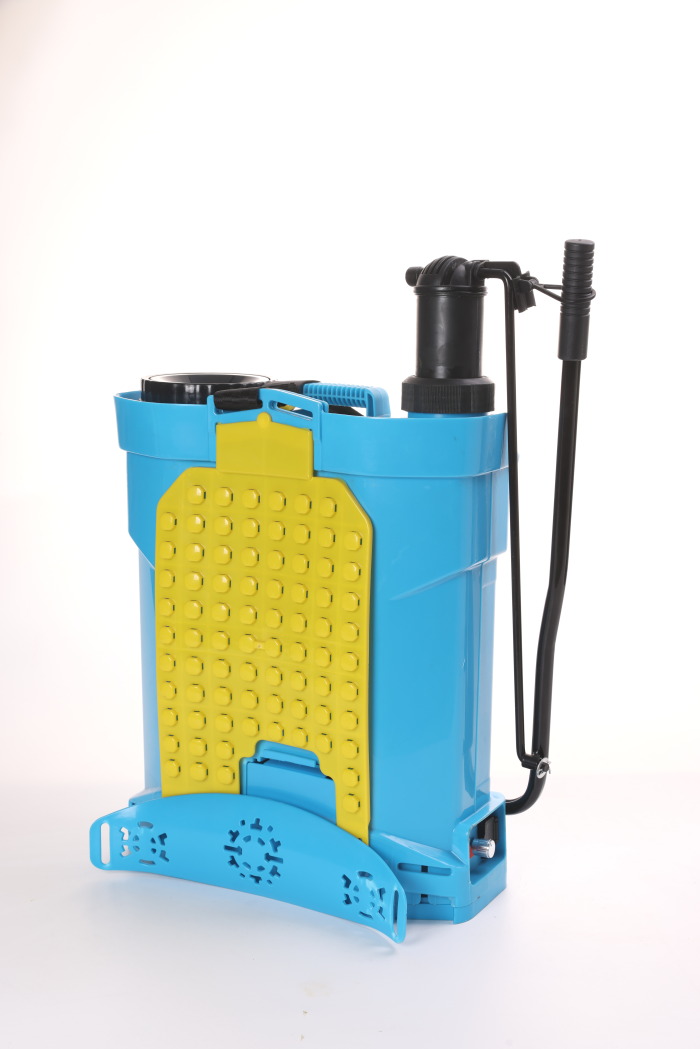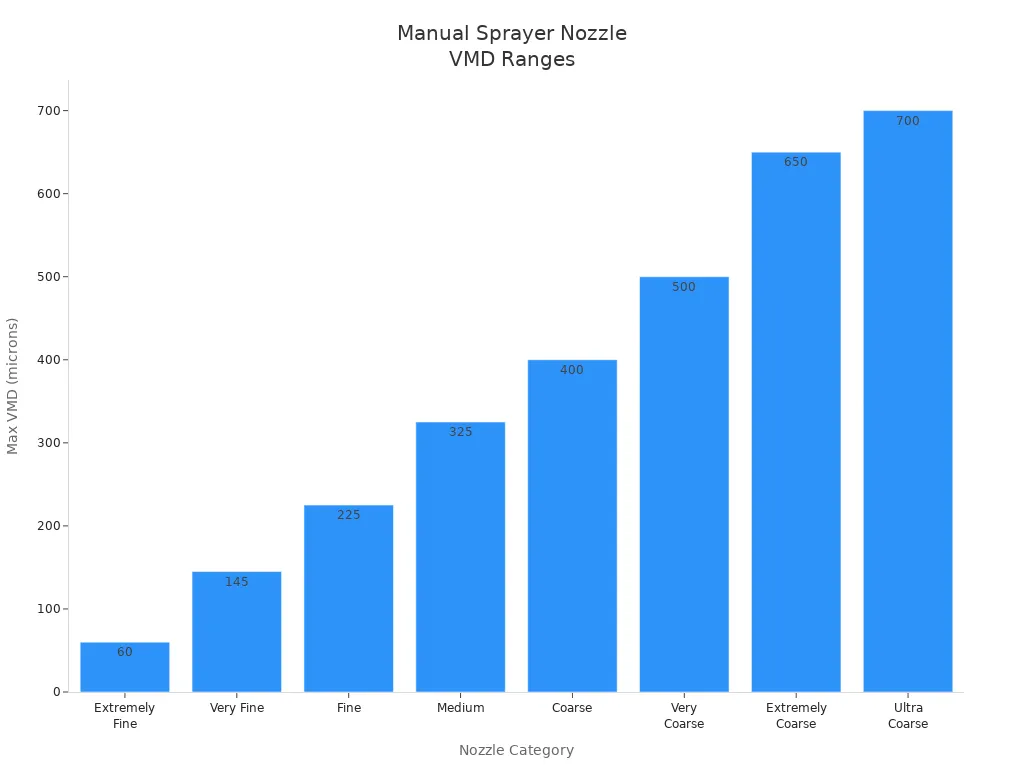Fax:0086-576-88129398
close
Choose Your Site
Global
Social Media
Views: 0 Author: Site Editor Publish Time: 2025-10-02 Origin: Site









Choosing the right spray nozzle size for your manual sprayer depends on what you’re spraying and how much coverage you want. Different plants and garden sizes need different nozzle types. Check out this table to see how nozzle size changes spray pattern and droplet size:
| Nozzle Type | Dv0.5 (microns) | Spray Quality | % Droplets (100-250 microns) |
|---|---|---|---|
| ISO F 110 02 | 214 | Fine (F) | 60% |
| ISO Injet 02 | 507 | Coarse (C) | 6% |
Pick the nozzle size that matches your spray material. Small nozzles let you control the spray better. Big nozzles can cover more space fast.
Try your sprayer before you start working. This helps you check if it covers well. It also stops you from using too much chemical.
Put on safety gear every time you spray. Wear gloves and eye protection to stay safe from chemicals.
When you pick a nozzle for your manual sprayer, you control how the spray lands on your plants. A smaller tip size gives you a finer spray pattern, which works best for thin materials like stains or when you want more control. Larger tip sizes create a wider spray pattern, making it easier to cover big areas quickly, especially with thicker solutions. You can also adjust the air cap position to change the spray pattern for different garden tasks. Here’s a quick look at how spray tip size affects the spray pattern:
| Spray Tip Size | Material Type | Effect on Spray Pattern |
|---|---|---|
| Smaller | Thinner | Finer, more control |
| Larger | Thicker | Wider, faster coverage |
Droplet size matters a lot for garden spraying. Smaller droplets cover more surface and help chemicals stick to leaves, which is great for fighting pests hidden in foliage. Larger droplets stay put better and reduce drift, so they work well in windy weather or when you want to avoid spraying nearby plants. The right nozzle size helps you get the droplet size you need for your garden. For example, contact pesticides need smaller droplets, while systemic ones do fine with larger droplets.
Pesticide spray drift happens when droplets move away from the target area. This can harm nearby crops, wildlife, and even pollinators like bees.
Using the correct nozzle size makes your spraying more efficient. You waste less chemical and get better results. If you use a nozzle that’s too big, you might flood your plants and waste product. If it’s too small, you could miss spots and need to spray again. Regular calibration of your manual sprayer helps keep droplet size consistent. Larger droplets are less likely to drift, while smaller ones can reach deep into dense canopies. Always match your nozzle to your garden’s needs and the weather conditions.
Common mistakes include picking the wrong nozzle for the chemical, ignoring weather, or not adjusting for plant type. These errors can lead to uneven coverage, wasted chemicals, and poor pest control.
When you pick a manual sprayer, you want to match it to your garden job. Are you spraying weeds, feeding your plants, or fighting bugs? Each task needs a different approach. Here’s a quick table to help you see what matters most when choosing your sprayer:
| Factor | Description |
|---|---|
| Pump Style | Manual piston or battery-powered; manual needs pumping, battery does not. |
| Size and Tank Capacity | Small sprayers hold about ¾ gallon; big backpack sprayers can hold 3 to 6 gallons. |
| Material | Look for heavy-duty plastic, brass, aluminum, or stainless steel for long life. |
| Weight | Remember, a gallon of liquid weighs over 8 pounds. |
| Nozzle Type | Adjustable nozzles let you change spray patterns for different jobs. |
| Maintenance | Clean the spray parts often to stop clogs and keep things working right. |
You might use a small handheld manual sprayer for houseplants or a big backpack sprayer for your lawn. Always think about how much you need to spray and how heavy the sprayer will feel when full.
The spray pattern changes how your manual sprayer covers your plants. You can pick from wide or narrow angles, and each works best for certain jobs:
Wide Angles (110°–120°): Great for spraying herbicides over large areas. You get broad coverage fast.
Narrow Angles (80°–95°): Good for spraying between rows or on single plants. You get more control and less waste.
Here’s a table to show which nozzle works best for each garden job:
| Application Type | Nozzle Type | Key Considerations |
|---|---|---|
| Herbicides | Flat fan | Best for even coverage on the ground. |
| Fungicides | Cone | Reaches deep into leaves and canopies. |
| Insecticides | Adjustable | Lets you change droplet size for different bugs. |
| General Use | Hollow cone | Good for spot spraying and less drift. |
You can also adjust the nozzle on your manual sprayer to switch between a fine mist and a strong stream. This helps you avoid spraying too much or too little.
Nozzle size affects how much liquid comes out and how big the droplets are. The right size helps you get the best results and avoid wasting chemicals. Here’s a simple chart to help you pick:
| Category | Symbol | Color Code | Approx. VMD Range (microns) |
|---|---|---|---|
| Extremely Fine | XF | Purple | <60 |
| Very Fine | VF | Red | 60-145 |
| Fine | F | Orange | 145-225 |
| Medium | M | Yellow | 226-325 |
| Coarse | C | Blue | 326-400 |
| Very Coarse | VC | Green | 401-500 |
| Extremely Coarse | EC | White | 501-650 |
| Ultra Coarse | UC | Black | >650 |

You can also look at the color code on your nozzle to know what size you have. For most garden jobs, medium to coarse nozzles work well. Fine nozzles are best for pests hiding in leaves, while coarse nozzles help stop drift on windy days.
Before you spray your whole garden, it’s smart to test your manual sprayer. This helps you make sure you get the right coverage and don’t waste chemicals. Here’s a simple step-by-step guide:
Check the Label: Look at your chemical’s label for the right spray volume.
Measure Your Speed: Walk 200 feet at your normal pace and time yourself. Do this three times and use the average.
Calculate Flow Rate: Use your time and the label info to figure out how much liquid you need per minute.
Pick the Right Nozzle: Choose a nozzle that matches your flow rate and pressure.
Adjust Pressure: After you install the nozzle, make small changes to the pressure to get the right spray.
Tip: Always test your manual sprayer with water first. Spray a small area and check the coverage. Adjust the nozzle or pressure if needed.
You can also fine-tune your manual sprayer by changing the nozzle pattern. Try a fine mist for delicate plants or a solid stream for tough weeds. Many manual sprayers have adjustable pressure settings and comfortable handles to make spraying easier.
Safety First!
Wear gloves, long sleeves, and eye protection when mixing or spraying chemicals.
Only open your manual sprayer after you vent any leftover pressure.
Clean your sprayer and nozzle after every use to stop clogs and keep it working well.
Check the weather before you spray. Don’t spray on windy days.
Note: Using the right nozzle and keeping your manual sprayer clean helps you get better results and keeps you safe.
Choosing the right nozzle size helps you spray your garden evenly and avoid wasting chemicals. Always check your sprayer instructions and nozzle charts for the best match. Test your setup before spraying. Clean your sprayer after each use and wear gloves and safety glasses to protect yourself.
Understand flow rates and droplet sizes for better results.
Regular maintenance keeps your sprayer working well.
Safety gear protects your health every time you spray.
If you see uneven coverage or need to spray the same spot twice, your nozzle might be too small. Try a larger size for better results.
You can use an adjustable nozzle for most tasks. For best results, switch nozzles based on the job and the chemical you use.
Clean your nozzle after every use. This helps prevent clogs and keeps your sprayer working well. Use water and a soft brush for easy cleaning.
Taizhou Guangfeng Plastic Co.,Ltd is specialized in manufacturing agriculture knapsack sprayers and garden sprayers for more than 28 years.Products exported to over 50 countries and our brand Farmguard shares great fame in the world. If you want to know more, welcome to contact us.
